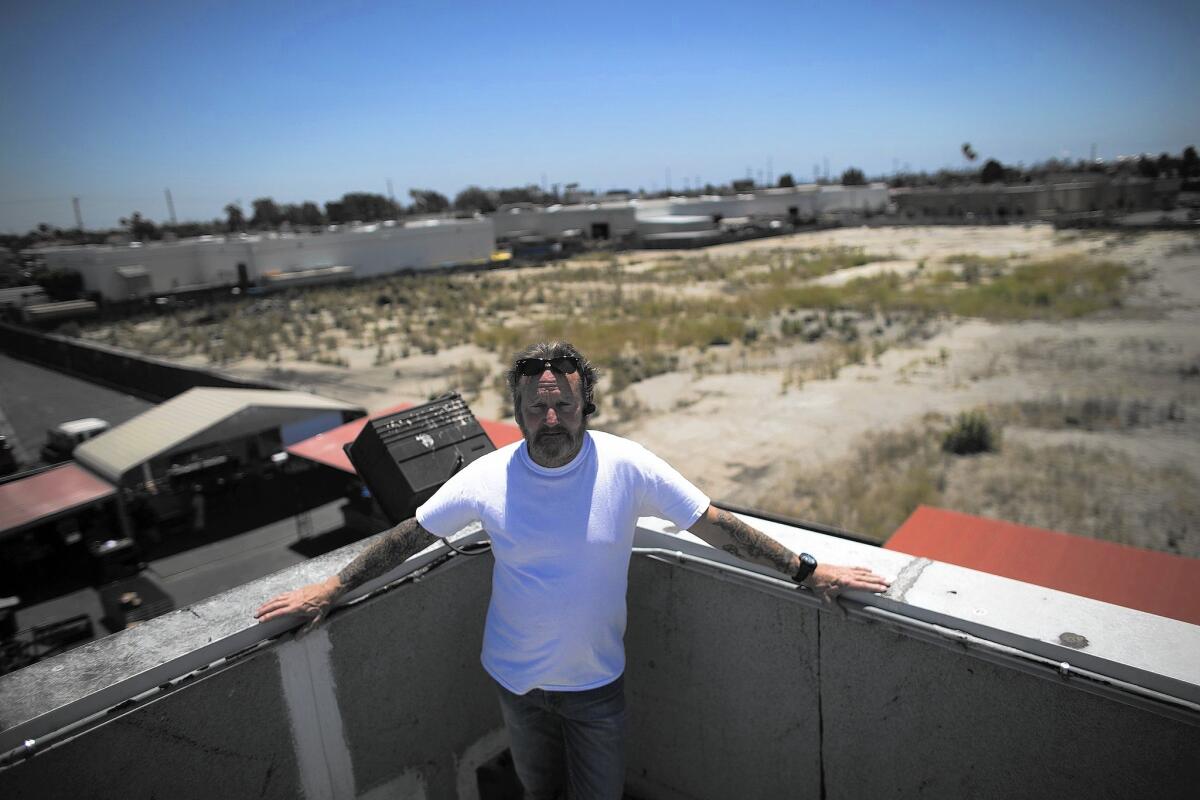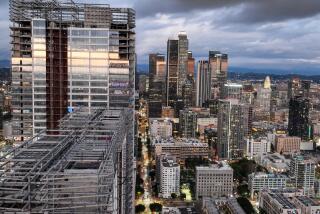First & Spring: Harbor Gateway apartments pit industry against City Hall

Robert Hardison, a manager at All Access Staging & Productions in Harbor Gateway, is opposed to a six-story apartment project slated to be built next to his firm’s property.
Band saws whine. Forklifts beep as they zip in and out of sheds. A worker slams his sledgehammer into a wooden staircase — a sound that echoes off nearby buildings.
All Access Staging & Productions, in L.A.’s Harbor Gateway neighborhood, is not an especially quiet workplace. Its employees build, ship and dismantle stage sets for concert tours and music festivals. A fair amount of that work takes place outside.
Now the company is expecting a new, unwelcome neighbor: a 352-unit apartment project known as Sea Breeze. The City Council, with Mayor Eric Garcetti’s support, approved the residential development this year, over the objections of All Access and the mayor’s own planning commissioners, who say it’s in exactly the wrong spot.
The dispute is, in some ways, a collision of two high-level City Hall priorities: encouraging job growth and increasing the number of available homes. Garcetti says Sea Breeze will bring much-needed housing to the neighborhood, helping him reach his goal of adding 100,000 new residential units citywide. Critics say the six-story project will undermine the future of manufacturing in the area — and is only the latest example of a developer obtaining lucrative, piecemeal changes to existing zoning rules.
“There will always be exceptions and adjustments” in city planning, said former Assemblyman Wally Knox, who ran unsuccessfully for council in March. “But in Los Angeles, the exceptions are swallowing the rule.”
In Harbor Gateway, developer A&M Properties persuaded the council to change the zoning on its 5-acre property, from one that specifies manufacturing activities to one that permits housing. The council granted the change despite a long-standing city policy that calls for the preservation of scarce industrial property — the kind that supports good-paying jobs.
The policy was created nearly a decade ago, after business leaders noticed that many of the city’s industrially zoned properties were being replaced by lofts, condominium projects and retail centers. The Sea Breeze site, just north of Sepulveda Boulevard, is surrounded by industrially zoned properties, city officials say.
Jim Arnone, the lawyer for A&M Properties, declined a request for comment. But in a letter sent to council members this year, he said the Sea Breeze site comprised .02% of the city’s industrial land. The push to change the zoning, Arnone wrote, reflects the “evolving nature” of the Sepulveda corridor and the Harbor Gateway neighborhood.
“The city possesses broad legislative authority to decide when it is in the community’s best interests to repurpose existing land use designations,” he wrote.
Granting developers case-by-case exceptions to established planning rules can be legally treacherous. In 2010, the council approved a 74-foot-high Target shopping center in Hollywood, in a location where such projects are limited to 35 feet. Foes of the shopping center sued and, after a judge overturned the city’s decision, work on the project stopped. The project has been idle since last year.
In April, Garcetti backed the approval of a 269-unit residential tower in Koreatown, even though the zoning for the site allowed only half that many homes. An advocacy group is now weighing a legal challenge.
In Harbor Gateway, property owner L&B Realty — which leases space to All Access Staging — is challenging the Sea Breeze project in court. Attorney Ben Reznik said the project’s environmental impact report failed to address the financial harm that would be experienced by nearby property owners, who assumed the zoning in the area would remain heavy industry.
Reznik contends that once Sea Breeze is fully occupied, its tenants will begin complaining about the noise created by nearby manufacturing businesses. Robert Hardison, a manager at All Access, agreed.
“If you’re on your balcony having a cocktail at 11 at night, and you’re hearing all these trucks moving back and forth, you’re not going to be happy,” he said. “The next step will be to eliminate us.”
L&B also leases space to the Los Angeles Times, which has a distribution center next to the Sea Breeze site. Times spokeswoman Hillary Manning said the company has no position on Sea Breeze. A representative of the newspaper attended at least one city meeting on the project and pointed out that work takes place at the distribution center late into the night, Reznik said.
Backers of the Sea Breeze project say there will be a sound wall and a 101-foot buffer between the new homes and nearby industrial buildings. They also argue that scores of new homes will produce economic benefits.
“It’s growth in the community. And when you have growth, that’s usually good for a community,” said Joeann Valle, executive director of the Harbor City/Harbor Gateway Chamber of Commerce, which sent a letter supporting Sea Breeze.
Zoning laws exist, in part, to isolate neighborhoods from uses that are considered incompatible, such as meatpacking plants. Those rules also provide property owners predictability, letting them know what could be built on the land that surrounds them, said Senior City Planner Shana Bonstin.
When Sea Breeze first came up for a vote last year, planning officials recommended an across-the board denial of the developer’s request for a zone change and various exceptions from city rules. They pointed to the policy of protecting land reserved for manufacturing businesses.
“We have a need for housing,” City Planner Greg Shoop told the Planning Commission. “But we also have a need for those jobs.”
The commission voted 7 to 0 to reject the project. Garcetti later disapproved the action, and Councilman Joe Buscaino, who represents Harbor Gateway, persuaded his colleagues to formally overturn the commission’s decision in February.
Buscaino described the long-vacant Sea Breeze site as a nuisance and said it no longer works as a place for industrial businesses. In a statement, he said Sea Breeze would help address the region’s housing crisis.
Planning Commissioner Richard Katz, a Garcetti appointee, said in an interview that he cast his vote against the Sea Breeze project to “maintain the integrity of the zoning process.”
“Zoning has to mean something,” he said, “or you wind up with cities like Houston … where you find propane tanks next to residents.”
Twitter: @DavidZahniser
More to Read
Start your day right
Sign up for Essential California for news, features and recommendations from the L.A. Times and beyond in your inbox six days a week.
You may occasionally receive promotional content from the Los Angeles Times.






